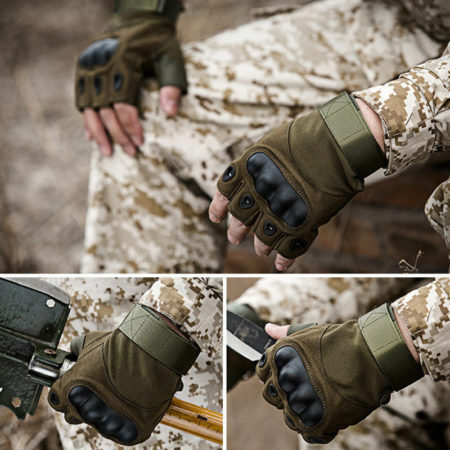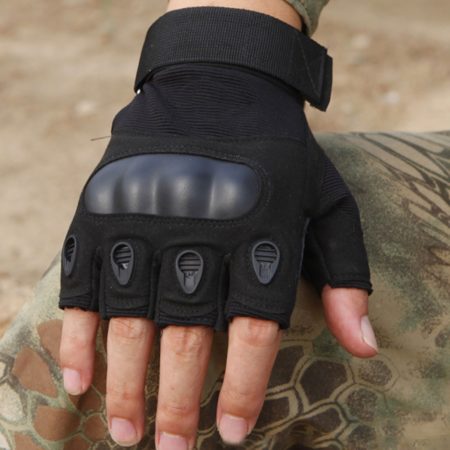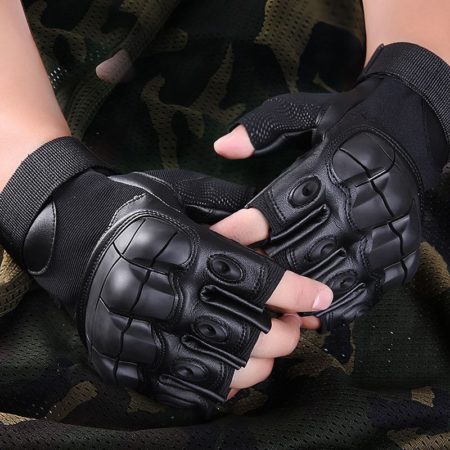Tactical gloves are an integral part of almost every man's wardrobe. Why almost everyone? Because guys who are not used to doing things with their own hands or who don’t like to spend time actively will not need them.

Tactical gloves - what are they and what are they for?
Tactical (shooting) gloves are called, which differ from ordinary, leather or knitted ones by the presence of special protective elements. Since the hands are considered the most traumatic part of the body, they account for the majority of injuries and injuries. Gloves with durable protective elements help avoid injury to joints, hands and skin when performing certain actions and tasks.

The first analogues of protective gloves appeared after the end of World War II, however, they gained wide popularity only in our time.
Types of tactical gloves
Depending on the scope of application, the following types are distinguished:
1. No fingers. Models in which the fingers remain open are used by athletes (airsoft players, biathletes, racing drivers) and the military, who really need tactile sensations. Unlike other models, fingerless ones are more maneuverable, comfortable and functional. They are often worn by carpenters or masons, who may accidentally injure themselves or burn themselves while working.

2. With fingers. Full-fingered gloves have a wide range of applications. For military personnel and members of assault groups, they are a mandatory part of protective and camouflage suits. Race car drivers and motorcyclists wear them to protect their hands in case of accidents and other unforeseen situations. Hunters can use tactical finger gloves to protect their hands while walking long distances through wooded and swampy terrain.

3. With brass knuckles. Gloves of an anatomical structure and cut with brass knuckles made of plastic or carbon on the joints are also in great demand among the military and hunters. According to their structure, they can be either with or without fingers. The protective pad on the joints reliably protects them from damage without hindering the movements of the hand and fingers.

4. Warm. Insulated models are in great demand among lovers of winter hunting and fishing. Despite the fact that they can be used at sub-zero temperatures, the person wearing them does not lose tactile sensations. Some models are even equipped with special inserts on the index fingers and thumbs, making it possible to freely handle touch and ultra-sensitive electronics.

Some models, in addition to being resistant to low temperatures, can be waterproof and resistant to various chemicals.
Materials used to make tactical gloves

The materials from which hand protective accessories are made mainly consist of synthetic and natural fibers, which are distinguished by their strength and wear resistance. Internal elastic bands help them to sit well and securely on the hand, which does not limit its movement.
The main materials used for sewing tactical gloves are:
- Genuine Leather. Dressed suede or smooth leather can be used both for sewing the entire product and for individual inserts on the palms, knuckles or fingers. They are easy to clean, reliably protect, but take a long time to dry after contact with water.
- Faux leather. Modern technologies for the production of eco-leather have been able to bring it to a state in which its characteristics are in many ways superior to its natural counterpart. Eco-leather inserts prevent slipping when in contact with metal.
- Synthetics. Non-flammable Kevlar and neoprene are distinguished by their strength and ability to allow air to pass through well, which prevents the skin of your hands from sweating. They perfectly combine the qualities of leather and fabric models.
- Cotton. Cotton fabric is highly breathable, dries quickly and is easy to clean. However, frequent use of natural cotton gloves significantly reduces their overall service life.

Knuckle pads can be made of hard and flexible plastic, carbon or metal. Lightweight and durable one-piece designs avoid impacts and bruises.
Conclusion

Choosing tactical gloves it is necessary to focus on the following factors:
- Convenience. The product should be the right size and fit snugly on your hand without squeezing it. The skin should not sweat or itch when in contact with the inside.
- Quality. Purchasing a cheap replica of a well-known brand, from which the threads stick out and the seams come apart, will be a complete disappointment. A high-quality item that can maximally fulfill the tasks assigned to it can only be purchased in specialized stores or ordered directly from the manufacturer via the Internet.
Those who use tactical gloves consider them an indispensable accessory both in work, sports and in everyday life. You can take them with you fishing, cycling or going to sports training. hall.


 0
0






With brass knuckles, brass knuckles are a cold weapon. If you hit a turnip, it’s no longer a beating, it’s already a real sentence. Well, imposing your (expert) opinion is at least ugly. I’m a military surgeon, I don’t wear such gloves